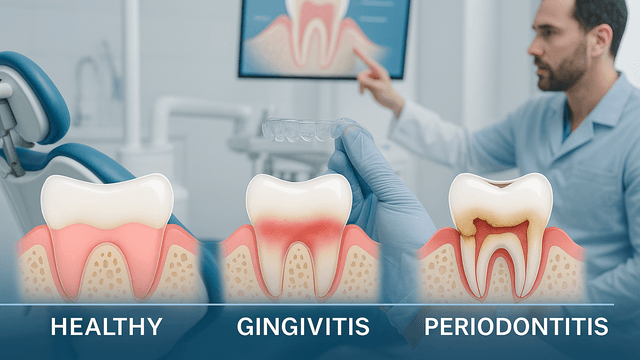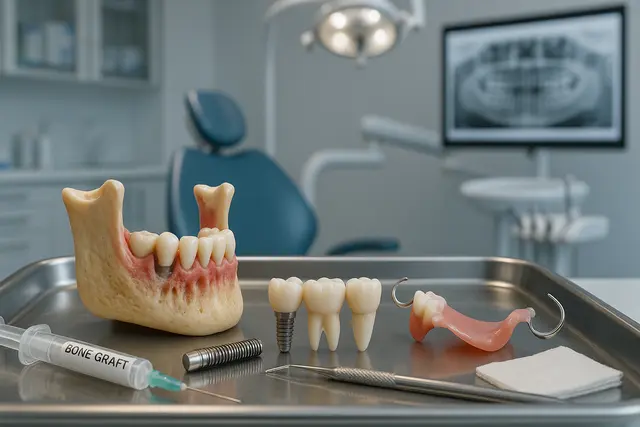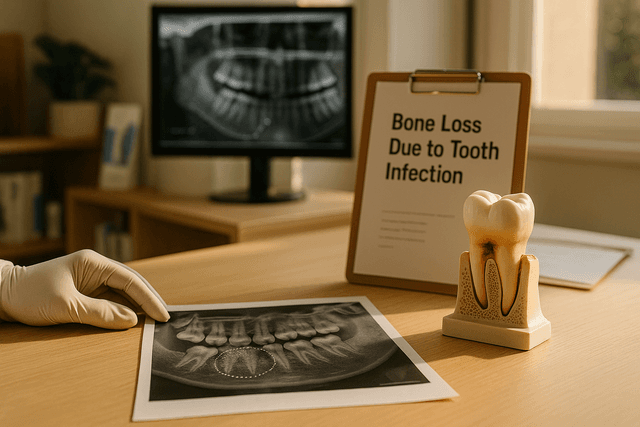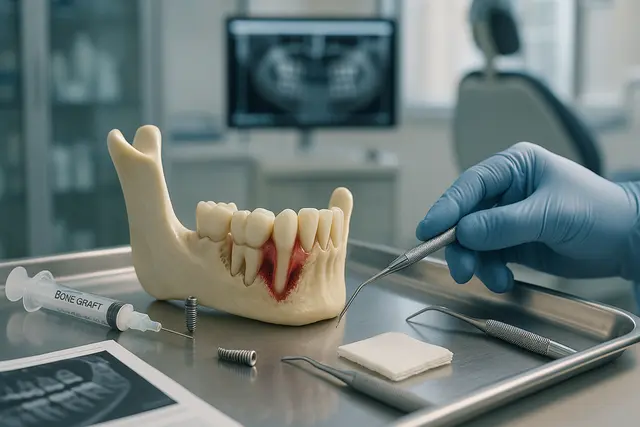Oral Health
6 min read
Jul 10, 2025
How Long Does It Take to Get Periodontal Disease?
Think gum disease takes years to develop? Think again. Periodontal disease doesn’t show up overnight, but it doesn’t drag its feet either. With just a few missed flosses and skipped dental visits, your gums can go from healthy to inflamed faster than you'd expect.

Most of us don’t think about our gums until something starts bleeding, swelling, or hurting. But here’s the thing: your gums are the quiet protectors of your teeth, and when they start breaking down, the rest of your mouth can spiral fast. So how long does it actually take to get periodontal disease? The short answer: it varies. The longer answer? Let’s walk through it step by step.
Understanding Periodontal Disease: The Sneaky Saboteur of Oral Health
Periodontal disease, also known as gum disease, doesn’t show up overnight with a trumpet fanfare. It’s slow, quiet, and sneaky. It begins with a buildup of plaque, that soft, sticky film of bacteria that hangs out on your teeth and along your gum line. If you don’t brush and floss it away regularly, it hardens into tartar, and that’s when the trouble starts.
From there, the bacteria that cause gum disease begin to irritate and inflame the gum tissue. This early inflammation is called gingivitis, the earliest stage of gum disease. You might notice some bleeding when you brush, mild swelling, or tenderness, but it’s easy to ignore. That’s what makes gingivitis dangerous. Left untreated, gingivitis can progress to periodontitis, a more serious form of gum disease that can lead to gum recession, bone loss, and yes, tooth loss.
Gum Disease Doesn’t Follow a Set Schedule But It’s Not Instant
Some people can go months or years without proper oral hygiene before they see serious damage, while others develop symptoms quickly. Genetics, smoking, diet, stress, and even hormonal changes can influence how fast gum disease develops.
If you're brushing inconsistently, skipping floss, or haven’t seen a dentist in years, you might see the earliest signs of gum disease within just a few weeks. People with mild gum disease might notice visible signs of gingivitis after a month of poor habits. And if that early stage of gum disease isn’t treated, it can progress to periodontitis within just a few months to a year.
Gingivitis: The First (and Most Reversible) Stage of Gum Disease
Gingivitis is the red flag your mouth waves when your gums are in distress. It’s the earliest stage of gum disease and shows up as bleeding when brushing, tender gums, and sometimes bad breath. But here’s the good news: it’s fully reversible with good oral hygiene and a visit to your dentist.
This stage usually doesn’t involve permanent damage to the bone and gum tissue. But if gingivitis is left untreated, it doesn’t just hang around; it levels up. That’s when it becomes periodontitis.
When the Disease Progresses: From Early Periodontal Disease to Moderate Periodontitis
Once gingivitis turns into periodontitis, things get a bit more serious. Early periodontitis shows up when plaque and tartar start moving under the gum line. This causes chronic inflammation, which triggers your body to begin breaking down bone and gum tissue. You might notice gum recession, pockets forming around your teeth, or even some wiggly teeth.
In moderate periodontitis, these symptoms intensify. The pockets deepen, gum and bone loss continue, and you may begin to lose the support that keeps your teeth anchored. At this stage, your oral hygiene routine alone won’t cut it. You’ll need professional treatment, like scaling and root planing, or possibly a gum graft to manage the disease and slow the damage.
Advanced Periodontal Disease: What Happens If You Don’t Seek Treatment
Advanced periodontal disease is when everything comes to a head. At this stage, the gums are severely receded, bone loss is significant, and your teeth may feel loose or even fall out. The infection can become chronic and painful, and it’s not just your mouth at risk. Gum disease often links to systemic conditions like heart disease, diabetes, and even Alzheimer’s.
Once the disease reaches this point, periodontal disease treatment becomes more complex. It may involve gum graft surgery to replace lost gum tissue, extractions, or even the need for a dental implant to replace lost teeth.
Dental Care and the Stages of Gum Disease: Where Do You Stand?
Understanding the stages of gum disease is key to stopping it before it causes irreversible damage. Let’s break it down quickly:
Gingivitis: Bleeding, swelling, and mild irritation. Fully reversible.
Early periodontitis: Beginning bone and gum loss. Pockets may form.
Moderate periodontitis: Deeper pockets, moderate bone and gum loss, teeth at risk.
Advanced periodontal disease: Significant damage, severe recession, potential tooth loss.
Knowing where you fall in the progression of gum disease can help you and your dentist create a personalized treatment plan that meets your needs, and potentially saves your smile. This is also when many consider dental implants after gum disease if teeth are lost.
So, How Long Does It Really Take?
There’s no single timeline. For some, gingivitis can appear in just two to three weeks of neglect. For others, especially those genetically predisposed, things may move faster. But the progression of periodontal disease depends on one major factor: how soon you act.
If you notice the symptoms of gingivitis, bleeding, swollen gums, tenderness, don’t wait. That’s your early warning. Treat gingivitis early and you can prevent gum disease from spiraling into something much worse. But if the disease progresses, it can become a lifelong condition. Periodontal disease is a chronic condition, and while it can be managed, it’s difficult to fully reverse once you’ve hit the later stages.
How to Prevent Gum Disease Before It Starts
The best gum disease treatment is prevention. Sounds cliché, but it's true. Here's how to prevent the gum problems that lead to disease:
Brush your teeth twice a day with a fluoride toothpaste
Floss daily, yes, every day (your gums will thank you)
Use an antimicrobial mouthwash if recommended
See your dentist or dental hygienist every six months
Don’t smoke; it increases your risk dramatically
Eat a balanced diet to support your oral health
These habits protect not just your gums but the teeth and gums that rely on them for support. Plus, they reduce your need for costly treatments like scaling and root planing or even a dental implant down the line.
If You’re Experiencing Symptoms of Gum Trouble, Act Now
If your gums bleed, look puffy, or feel sore, or if you notice gum recession or loose teeth, don’t assume it’ll just go away. These are symptoms of periodontal disease. Seeking treatment early could mean the difference between a quick cleaning and a long road of gum disease treatment and periodontal procedures.
Your dentist can assess the stage of gum disease you’re in, evaluate the gum and bone health, and recommend steps to treat gum disease effectively. For those in later stages, treatment might involve periodontal surgery, antibiotics, or bone and gum graft surgery.
Keep Your Teeth with Periodontal Care and Stay Ahead of Disease Progression
The goal isn’t just to stop the bleeding; it’s to keep your teeth with periodontal support that lasts a lifetime. Treating periodontal disease early gives you the best chance of avoiding tooth loss and protecting your oral health and overall wellbeing long term. If you're already living with teeth with periodontal disease, consistent treatment and maintenance are key.
And yes, a treatment plan to help you bounce back is entirely possible. Whether you’re in the early stages or deeper into the journey, professional care can dramatically improve your outlook.
Don’t Wait for the Pain to Start
Gum disease develops quietly, but it speaks volumes when ignored. The progression of gum disease, from the earliest signs of gingivitis to the advanced stages of periodontal disease, is entirely preventable with care, consistency, and a bit of vigilance. The disease may sneak in slow, but your response doesn’t have to be.
So brush up, floss often, and see your dental team before your gums start waving the white flag. Prevention isn’t just smart; it’s your best weapon against the severity of the disease.
Because honestly? A lifetime of strong, healthy gums is worth the few minutes it takes each day to care for them. And if you're already noticing bleeding gums, take that as your sign to act.
How Long Does It Take for Gum Disease to Develop?
Gum disease doesn’t appear overnight. Gingivitis, the earliest stage, can develop within 2–3 weeks of poor oral hygiene. If left untreated, it can progress to periodontitis over several months to a year. The timeline varies depending on factors like genetics, smoking, and oral care habits.
What Are the Stages of Periodontal Disease?
There are four main stages:
Gingivitis – Reversible inflammation with bleeding and swelling.
Early Periodontitis – Mild bone and gum loss with pocket formation.
Moderate Periodontitis – Deeper pockets, bone loss, and loosening teeth.
Advanced Periodontitis – Severe damage, tooth mobility, and potential tooth loss.
Can Periodontal Disease Be Reversed?
Only the earliest stage, gingivitis, is fully reversible with consistent brushing, flossing, and professional dental care. Once the disease advances to periodontitis, the damage can be managed and slowed, but not completely reversed without more complex treatments.
How Can I Prevent Gum Disease From Starting?
Preventing gum disease starts with daily brushing and flossing, regular dental cleanings, avoiding tobacco, and maintaining a balanced diet. Using an antimicrobial mouthwash and visiting your dentist every six months also helps reduce your risk significantly.
Read Next
Related Posts

Oral Health
Tooth Replacement Options to Prevent Bone Loss
Losing a tooth isn’t just about appearance, it can have a lasting impact on your oral health, jawbone strength, and overall quality of life. When teeth go missing, the jawbone begins to shrink, which can change your bite, your facial structure, and even your confidence. Fortunately, modern dentistry offers several effective solutions to replace missing teeth and prevent further bone loss.
4 min read
Sep 26, 2025

Oral Health
Bone Loss Due to Tooth Infection Explained: What It Means for Your Oral Health
A tooth infection isn’t just about pain, it can quietly damage the tissues around a tooth and even erode the jawbone that supports your smile. This guide explains how infections start, why they can lead to bone loss, the warning signs to watch for, and the treatments that can stop the spread and rebuild lost support.
5 min read
Sep 25, 2025

Oral Health
Understanding Bone Loss in Teeth: Causes and Treatments That Work
Bone loss in teeth is a silent threat that can compromise your smile, facial structure, and overall oral health. While it often goes unnoticed in the early stages, it can lead to serious consequences if left untreated. Understanding what causes dental bone loss, and how to prevent or manage it, is key to maintaining a strong, healthy foundation for your teeth.
5 min read
Sep 25, 2025
Don’t have time to research every dentist around you?
See why 30k+ patients trusted us